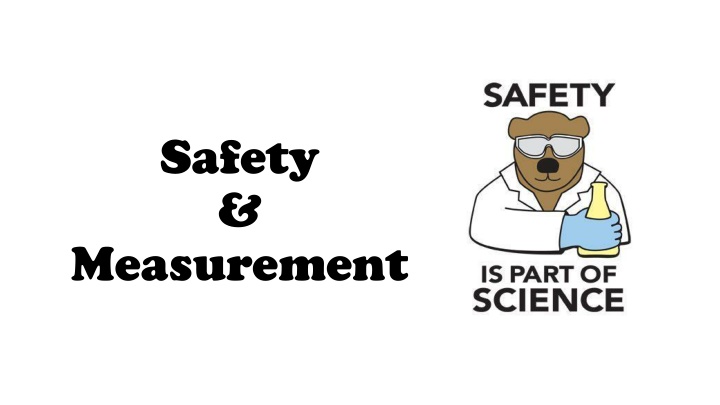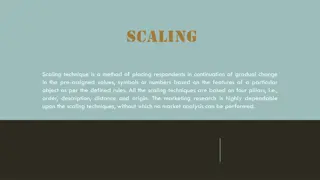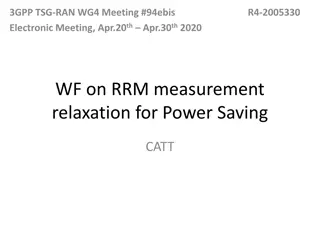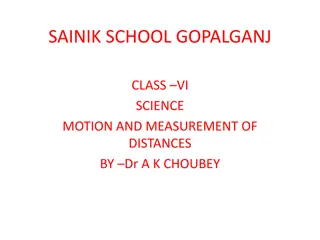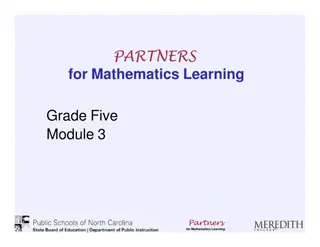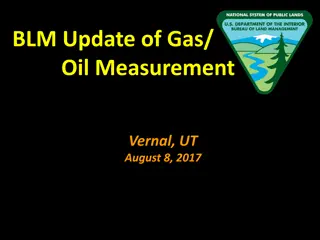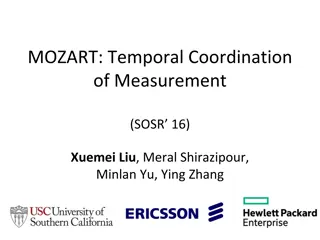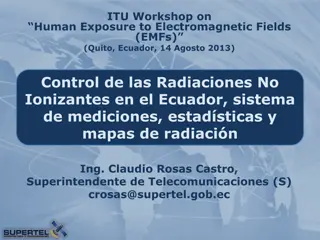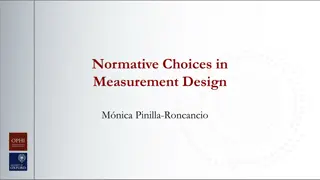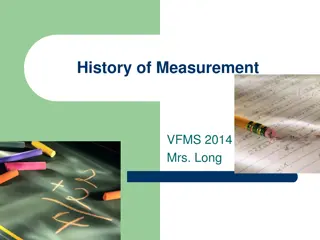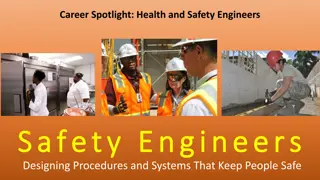Science Classroom Safety and Measurement Guidelines
Learn about the importance of safety in the science classroom, with top guidelines including no eating or drinking, following directions, wearing safety gear, and practicing careful measurement. Understand the key aspects of thinking like a scientist, measurement techniques, metric units, and how to calculate distance, volume, mass, and density. Explore the essential practices for conducting safe and accurate scientific experiments.
Download Presentation

Please find below an Image/Link to download the presentation.
The content on the website is provided AS IS for your information and personal use only. It may not be sold, licensed, or shared on other websites without obtaining consent from the author.If you encounter any issues during the download, it is possible that the publisher has removed the file from their server.
You are allowed to download the files provided on this website for personal or commercial use, subject to the condition that they are used lawfully. All files are the property of their respective owners.
The content on the website is provided AS IS for your information and personal use only. It may not be sold, licensed, or shared on other websites without obtaining consent from the author.
E N D
Presentation Transcript
Safety & Measurement
Safety in the Science Classroom Safety in the Science Classroom Top Top 10 1. No eating or drinking 2. No playing around in the room 3. Follow all written & verbal directions 4. Do not touch anything until told 5. Wear safety goggles/gloves as needed 6. Report any accident immediately 7. Don t not touch or smell anything unless told 8. Do not remove anything from the classroom 9. Do not enter storage areas or open cabinets 10.Wash hands before leaving the science room 10
Thinking Like a Scientist Thinking Like a Scientist Observe Question Hypothesize Record, Organize & Analyze Data Draw Conclusions Measure Infer Compare & Contrast Explain Model Communicate Practice Safety
Measurement Measurement BrainPOP! Measuring Matter Metrics
Measurement Measurement Practicing careful measurement is an important part of science. How do we measure? What units are used?
Term Distance/Lengt h Volume Mass Density Amount of space an object takes up Amount of matter in an object A ratio that compares the mass of an object to its volume OR how tightly packed the matter is within an object. How far apart objects are or the physical length of an object Definition How can we find it? L x W x H OR displacement in water: Use a scale / balance Calculate Density: Car odometers Meter sticks Rulers Measuring tapes D= M / V (*Don t confuse mass with weight that is affected by the gravitational pull on an object) Measure the water in a graduated cylinder then drop in the object & measure again. Subtract the two amounts & you have the volume of the object. Density = Mass Volume
Metric Units (commonly) Liter (ml OR kl) Grams (kg OR mg) Cubic centimeter cm3 Meter (km OR cm OR mm) Measured by Graduated Cylinder or Beaker Balance Calculation See above Practice Measuring (Always include units!) Reading a graduated cylinder: _____ _____ _____ Reading a beaker: _____ _____ _____ Using an electronic balance: Rock: _____ Paper clip: _____ Legos: _____ Using graduated cylinder & balance (follow displacement directions under volume & formula under density): Vol: ______ Mass: ______ Paper Clip: ____ Pen: ____ Table height: ____ Your shoe: ____ Door handle to floor:____ Volume using Displacement: Rock: _____ Mineral Density: ______
Tools of Measurement Graduated Cylinder Beaker Triple Beam Balance Electronic Balance
Metric Conversions Metric Conversions (King Henry Doesn t Usually Drink Chocolate Milk)
Practicing Measurement Practicing Measurement We will do Displacement & Density together Group Rules: Little Voices Follow safety rules Respect each other Take turns Work together to accomplish your tasks Check your work especially the units you used! Clean up / straighten up materials
Temperature Temperature Read the passage, Measuring Temperature Use the passage to help fill in the temps for the Measuring Temperature table Use the passage to answer the 3 questions Watch BrainPop: Temperature
Measuring Temperature Freezing Point Boiling Point Celsius Fahrenheit 32 F 0 C 100 C 212 F Which one is used mostly in science? CELSIUS CELSIUS Which tool is used to measure temp? THERMOMETER THERMOMETER
Why does the tool work? Why does the tool work? Thermometers work to determine temperature because liquid changes volume (the amount of space it takes up) based on the temperature. When a liquid is cold it takes up less space than it does when it is warmer. Thermometers use a large bulb filled with liquid & a small tube to show the changes because the changes are very small.
Customary vs. Metric Measurement Customary vs. Metric Measurement Watch BrainPop: Customary Units Talk about converting from one to the other
Review for the Quiz: Review for the Quiz: Safety & Measurement Safety & Measurement 1.Amount of matter in an object Matching: 2.A ratio that compares the mass of an object to its volume A. Mass B. Volume C. Density D. Weight 3.Affected by the amount of gravity pulling on an object 4.Amount of space an object takes up
1. A. Mass 2. C. Density 3. D. Weight 4. B. Volume
1.The basic unit for mass Matching Matching: 2.The basic unit for length A. Meter B. Gram C. Liter 3.The basic unit for volume
1.The basic unit for mass = B. gram 2.The basic unit for length = A. meter 3.The basic unit for volume = C. liter
The thickness of a coin would be The thickness of a coin would be approximately 1 ___. approximately 1 ___. A. Meter B. Centimeter C. Millimeter D. Kilometer
The distance from the door knob to the floor is The distance from the door knob to the floor is approximately 1 ___. approximately 1 ___. A. Meter B. Centimeter C. Millimeter D. Kilometer
A. Meter A. Meter A meter stick = the distance from the floor to the door handle
If your family was planning a trip from home to If your family was planning a trip from home to California, which unit of measurement would you California, which unit of measurement would you use to figure out the distance you will travel? use to figure out the distance you will travel? A. Meter B. Centimeter C. Millimeter D. Kilometer
D. Kilometer D. Kilometer
What is each of these used to measure? What is each of these used to measure? (Answer choices: volume, distance, mass) (Answer choices: volume, distance, mass) Graduated Cylinder Balance Meter Stick Beaker
Graduated Cylinder Balance Meter Stick Beaker Volume Mass Distance Volume
What is the What is the freezing point freezing point of water using each scale: of water using each scale: Celsius scale = ____ Fahrenheit scale = ____
Celsius scale = 0 Celsius scale = 0 C C Fahrenheit scale = 32 Fahrenheit scale = 32 F F
Complete the metric conversions, using the ladder Complete the metric conversions, using the ladder (K King H Henry D Doesn t U Usually D Drink C Chocolate M Milk) 1) 3000 mg = ___ g 4) 550 m = ___ km 5) 150 cm = ___ mm 2) 18 km = ___ m 6) 4000 mm = ___ Km 3) 7 L = ___ mL
(K King H Henry D Doesnt U Usually D Drink C Chocolate M Milk) 1) 3000 mg = 3 g 4) 550 m = .55 km 2) 18 km = 18,000 m 5) 150 cm = 1500 mm 3) 7 L = 7,000 mL 6) 4000 mm = .004 Km
List as many science List as many science lab safety rules lab safety rules as you can think of as you can think of GO GO! !
1. No eating or drinking 2. No playing around in the room 3. Follow all written & verbal directions 4. Do not touch anything until told 5. Wear safety goggles/gloves as needed 6. Report any accident immediately 7. Don t not touch or smell anything unless told 8. Do not remove anything from the classroom 9. Do not enter storage areas or open cabinets 10.Wash hands before leaving the science room
